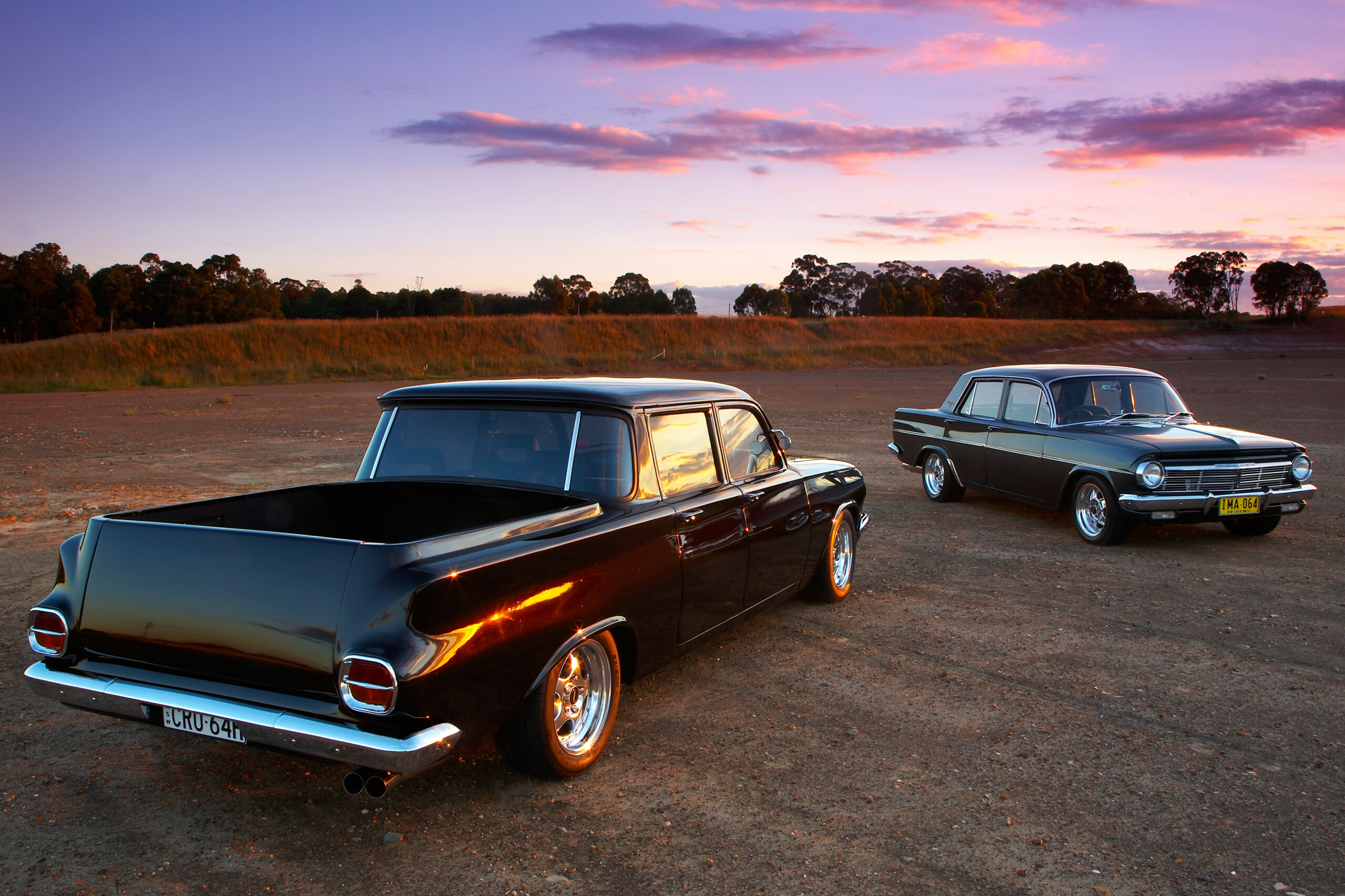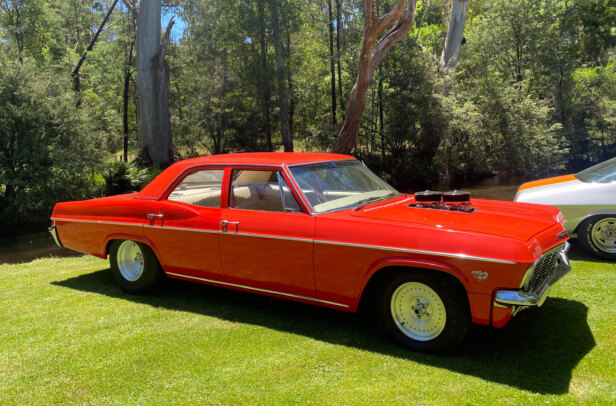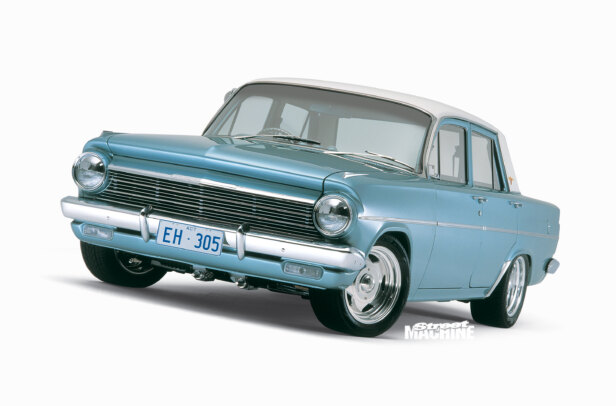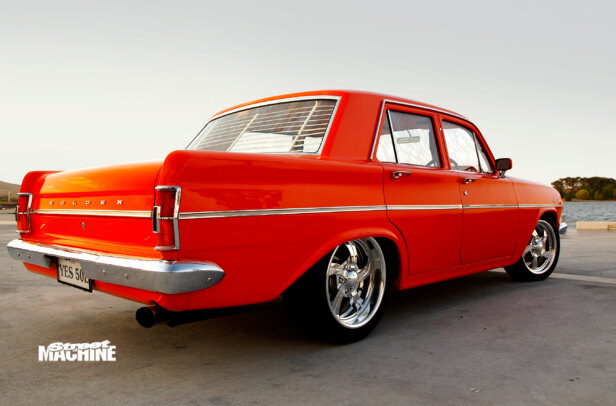One sensational road car is usually challenge enough for most of us, but Sydney fitter/machinist Luke Johnson jangles the keys to two jaw-dropping EH Holdens – one with twin-turbo Nissan Skyline GT-R power, the other with an injected Commodore V8 in a self-built dual-cab body.
First published in the August 2008 issue of Street Machine
“I’ve been into Holdens for about 25 years, but my first car was a Celica,” admits Luke. “Then I had a Charger, and a Cortina with a V8 in it. Then I got into EHs.” This particular EH Holden sedan was bought in 1989, and modified with the gear of the era – a Holden six-cylinder Red with a Rajay turbo and side-draft Weber, Aussie four-speed gearbox, and nine-inch diff.
But Luke reckoned he made a mistake with the nine-inch. “It was too heavy. It felt like I had a box trailer on the back, donging around underneath!” he reckons. “So, I began looking for an alternative.”
The smooth ride of Luke’s family car, a VQ Holden Statesman, gave him an idea: independent suspension. Luke knew the Holden IRS was too large for an EH, but a walk around a wrecker’s with a ‘measuring stick’ revealed that an IRS from a Nissan 280ZX would – or could – be a good fit.
“It was pretty close,” Luke says. “I narrowed the track and made up some brackets where the spring hangers normally go. In the boot, I reinforced things and installed a brace that runs between the chassis rails to accept the coil-overs into the same place the [EH’s] shocks were.”
Luke makes it sound so easy, doesn’t he? He was happy with the poise the IRS gave the turbocharged EH, but his smile faded in the looming doom of a world without leaded fuel – at that point, it was to be phased out around 1999-2000.
“I began looking at injected motors and transplants,” he says. “You know what it’s like – you go to a show, and see what other people have done. The VL Commodore’s six-cylinder EFI engine was looking pretty good, but my son Jeremy is into Skylines, and he got me thinking about an import engine. I found a single-turbo RB25DET in a front-cut, but he piped up and said, ‘Dad, if you buy that, you’ll be sorry! You gotta get the GT-R twin-turbo! If you’re going to do this, you gotta do it good!’”
Jeremy was on the money there. The RB26DETT is the engine that powers the Bathurst-killing, all-wheel-drive Nissan GT-R, and, besides twin turbos, the little mill is built like a brick outhouse, revs to 8000rpm, and has fantastic potential for power upgrades over the factory-rated 206kW.
Like the IRS transplant, Luke makes the conversion sound easy. “I had to fabricate a sump out of stainless,” he says, as if he’s explaining how to butter toast. “Normally, this engine and sump has a diff on the side of it.” But, when he swung the engine at the EH’s engine bay for the first time, Luke frowned – but not for long. “It’s a big motor! I was thinking, ‘ke-r-r-ist almighty…’. The plenum is large, it’s got two turbos hanging off the side, it’s long, and its head is wide. Plus, I had to fit the fans in. In the end, there was no choice but to move the firewall back about three inches.”
Around three-quarters of the firewall was modified, including the section where the steering threads through. Like almost everything, Luke did the job himself with his MIG welder. The trans tunnel also needed a metal massage – the EH’s tunnel was too flat and low for the Nissan five-cogger. New mounts were required on the HR Holden ball-joint front suspension that Luke converted to rack-and-pinion steering, with a TE Ford Cortina rack, and a collapsible steering column from a Nissan Pintara.
More metal mods: the EH’s fuel tank was made bigger by splicing two tanks together. “A lot of people cut out the boot floor and install a Ford tank, or whatever,” says Luke. “This way was nice and simple.” The tank and a small anti-surge tank installed behind the rear seat feed dual Bosch fuel pumps that, in turn, satisfy the hunger of Godzilla hiding up front.
The Nissan 280ZX’s R200 diff has a clutch-style limited-slipper similar to the GTR’s original. The brakes are a mix of LH Torana up front and 280ZX down the rear. “I re-did the 280ZX flanges to take the Torana stud pattern,” Luke says. “That was the easiest way. I was lucky with the splines on the driveshafts; when I narrowed the subframe, there was enough ‘slide’ in the splines and joint to re-use them without shortening.”
Luke built his own exhaust, too, starting with three-inch mandrel sections from the two turbos, and feeding into a single three-inch stainless pipe that runs into a high-flow cat and a stainless rear-mount muffler. He polished the lot, too.
The turbos were rebuilt and upgraded with steel exhaust wheels in place of the GT-R’s standard shatter-prone ceramic jobbies. “It means I can boost it up safely. I’m running the standard management, but with a few Apexi bits.”
Greg at Autosport Engineering at Kirrawee, NSW, assisted with the engine-management wiring. “I had one-month warranty on the engine,” says Luke. “But, there was no way I was going to get it into the car and running in that time, yet I wanted to know if it was okay, or not. So, I went to Greg and said, ‘I want you to get it running in the trailer.’ He wired it up and fitted a radiator. All good.”
The wiring rigged-up to test the engine assisted in Luke’s mission to strip all unnecessary circuits from the original Nissan harness, and install it in the car without too much mucking around.
There are no silly-sounding blow-off valves on this turbo monster, with Luke retaining the Nissan’s BOV plumb-back to keep his engine-management system – and the law – happy. He did, however, mount them out of sight under a front guard. He also replaced most of the Nissan’s original rubber fluid and vacuum hoses with self-made stainless piping.
Outside, it’s ‘classic’ EH street-machine clobber, with subtle BMW-catalogue Spies Hecker paint and Simmons B45 wheels. (Luke did the prep, before a bloke named Steve, from a now-closed shop, applied the top coat.) Inside, it’s neat and clean, with Torana instruments grafted into the instrument binnacle and a Recaro-based re-trim.
“You think something is dead smooth – until black paint reveals every tiny defect”
With its more radical body mods and more sedate mechanicals, Luke’s other creation is the diametric opposite of the sedan. Like Luke, we’re happy to call his dual-cab EH a Crewman.
He says, “We were at an EH show, parked next to an EH limousine and a wagon, sedan and ute. Someone quipped, ‘Wow. Here’s all the possible body-styles represented,’ and my wife Sue said, ‘Naaah … there’s no dual-cab’.”
That comment kick-started the creation of the Crewman. Luke made a few sketches, and soon figured that a wagon (actually an EJ), with its longer, flatter roof would make the best ‘front bit’ for his radical dual-cab. The rear is, of course, a ute, but Luke realised the tray would have to be shortened to keep the proportions pleasing. Around 300mm was removed.
The cabin was cut behind the B-pillars at a point that provided plenty of rear-seat leg room before the two abbreviated shells were spliced together with extra reinforcment between the front of the rear-spring hangers and the front chassis rails. “I wanted to stiffen the shell, but not be too obvious,” Luke says. “I’ve sunk them into the floor, and with the carpet and underlay in place, you don’t even know they’re there.”
The shortened rear doors were simple in theory, but a challenge in practice. They’re the front of a pair of rear doors spliced to the rear of a set of fronts. Uh-huh. “God, what a mongrel that was,” recalls Luke of the effort required to make everything straight. “And I wanted to paint the thing black. Black is the biggest lie detector of all; you think something is smooth, dead smooth, until black paint goes on.
Then every tiny defect shows up.” Not only did Luke have to deal with the cut ’n’ shut doors, there was a subtle realignment of the shortened rear quarters to cope with, too. Ex-Ford Telstar electric windows went in, as did custom glass that deleted the front quarter windows. Eventually, the body got Luke’s seal of approval, before Steve again applied a top coat.
Keeping it in the family this time, Luke chose plenty of Holden components for the remainder of the Crewman’s build. The interior comprises Holden Rodeo front buckets (“as good as the Recaros in the sedan,” he says) and rear bench, and the instrument cluster is from a 1990s Holden Calais, complete with the top-shelf ‘three-window’ trip computer. The instruments are a hint as to what’s under the bonnet: a fuel-injected 5.0-litre V8.
Yep, this time, Luke stayed green and gold. “I’ve always enjoyed the laid-back nature of my Statesman engine, and I thought it would suit the Crewman a lot better,” he asserts. Installing it was a little easier than the twin-turbo Nissan donk in the sedan, although it still managed to soak up plenty of effort.
Internally standard, but taking command from an HSV 185kW programme, the engine sits on an HR ball-joint front end – same as the sedan – but this time,
Luke engineered a rear-mount power steering rack, using bits from a Barina. Sideshow’s Performance Wiring made the engine work with the cruise control and trip computer, and without the Commodore’s factory immobiliser. The front brakes are HZ alloy-bodied calipers on Commodore discs, squeezed using a Nissan 300ZX booster.
There was a fair bit of mucking around to get the clutch to work, too, with Luke scratch-building a clutch-pedal master/slave cylinder arrangement under the dash. Luke narrowed the Commodore axle housing to suit the slim-hipped EH, and slid in two ‘short-side’ standard axles. The gearbox is a T5 five-speed, and the Crewman’s floor required similar surgery to that of the sedan.
Two sensational street machines. We can’t wait to see what Luke does with the ’32 roadster he’s just got in the build!
Luke Johnson
1964 EH holden premier specs
| Colour: | Spies Hecker BMW grey |
|---|---|
| GRUNT | |
| Engine: | Nissan RB26DETT twin-turbo six |
| Capacity: | 2.6-litre |
| Internals: | Standard |
| Management: | Apexi-tweaked Nissan |
| Exhaust: | Dual 3in dump pipes |
| Sump: | Custom stainless steel |
| SHIFT | |
| Gearbox: | RB25DET five-speed |
| Clutch: | Nissan |
| Diff: | Nissan R200 in 280ZX IRS |
| BENEATH | |
| Suspension: | K-Mac and Gabriel (front) KYB gas (coil-over rear). HR Holden ball-joint front suspension with front-mount rack-and-pinion steering conversion |
| Brakes: | LH Torana front discs and calipers; Nissan 280ZX rears |
| WHEELS & TYRES | |
| Wheels: | 15×7 (f), 8in Simmons B45 (r) |
| Tyres: | 205 (f), 225/50 Kelly Charger (r) |
1964 EH holden crewman specs
| Colour: | Spies Hecker Jaguar Black |
|---|---|
| GRUNT | |
| Engine: | Holden EFI V8 |
| Capacity: | 5.0-litre |
| Internals: | Standard |
| Management: | Holden/Delco with HSV 185kW memcal |
| Exhaust: | Dual 2.5in stainless |
| Radiator: | Four-core |
| SHIFT | |
| Gearbox: | Commodore T5 five-speed |
| Tailshaft: | Fabricated |
| Diff: | Commodore/Borg Warner, narrowed |
| WHEELS & TYRES | |
| Suspension: | Lowered two inches; rear-mount power rack-and-pinion steering conversion on HR ball-joint front crossmember |
| Brakes: | Commodore four-wheel discs; HZ front calipers |
| Rolling stock | |
| Rims: | 15×7 (f) 8in Simmons (r) |
| Rubber: | 225/50 Nankangs |
THANKS
My family: Sue, Jeremy and Natalie. Steve for the paint. Greg at Autosport Engineering Kirrawee (02) 9521 1388. Sideshow’s




Comments